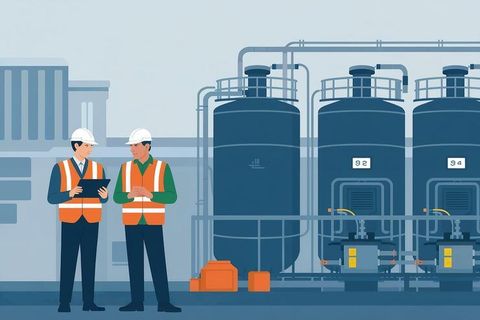A Complete Guide to Navigating Chemical Factory Environments Safely
Chemical factories are facilities where raw materials are transformed into products like plastics, paints, fertilizers, cleaning agents, or pharmaceuticals. These environments often involve toxic substances, high-pressure equipment, flammable chemicals, and heavy machinery. Because of this, working in such settings requires strict safety measures and awareness.
The concept of factory safety emerged to protect workers, reduce accidents, and maintain compliance with industrial regulations. Over time, advances in safety technologies, training, and government oversight have made chemical factory operations safer. Still, risks remain, making safety navigation a crucial priority.

Importance – Why chemical factory safety matters today
Chemical safety is vital for industries and society as a whole. Here’s why:
-
Protecting workers’ health: Exposure to hazardous chemicals can lead to respiratory illnesses, burns, skin irritation, and long-term diseases.
-
Preventing accidents: Proper safety practices reduce the risk of explosions, fires, and chemical spills, which can cause injuries and major financial losses.
-
Environmental protection: Chemical leaks can contaminate soil, air, and water, impacting local communities and ecosystems.
-
Regulatory compliance: Companies face fines, penalties, or shutdowns if they fail to meet safety standards.
-
Business continuity: Safer operations mean fewer accidents, lower insurance costs, and improved productivity.
For employees, managers, and regulators, safety is not just about compliance—it’s about ensuring health, efficiency, and sustainability.
Recent Updates – Trends in chemical factory safety (2024–2025)
The past year has seen significant developments in chemical safety practices:
-
Digital monitoring systems (2024): Factories increasingly use IoT sensors to track air quality, detect leaks, and monitor chemical storage conditions.
-
AI-driven risk assessment: Artificial intelligence tools now predict potential hazards by analyzing data from factory operations.
-
Wearable safety tech: Workers are adopting smart helmets and connected wristbands that alert them to toxic exposure.
-
Global accidents raise awareness: Incidents in Asia and Europe in 2024 highlighted the importance of strict adherence to chemical storage regulations.
-
Sustainability push: More companies are switching to greener chemicals and safer substitutes, reducing risks for employees.
These updates indicate a move toward automation, real-time monitoring, and greener materials in chemical manufacturing.
Laws or Policies – Regulations shaping chemical safety
Chemical safety is guided by national and international policies:
-
OSHA (Occupational Safety and Health Administration – USA): Sets strict rules on handling chemicals, protective gear, and worker training.
-
EU REACH Regulation: Controls the production and use of chemical substances across Europe.
-
Factories Act (India): Enforces workplace safety, equipment standards, and worker health protection.
-
GHS (Globally Harmonized System): Standardizes chemical labeling and hazard communication worldwide.
-
Environmental Protection Laws: Govern waste disposal and emissions to prevent environmental damage.
Compliance with these regulations ensures factories maintain worker safety, environmental sustainability, and operational legality.
Tools and Resources – Supporting safe navigation in chemical factories
Several tools and resources can help industries and employees maintain safety:
Digital Tools & Software
-
Hazardous Material Tracking Apps (ChemAlert, Sphera): Monitor chemical inventory and risks.
-
Safety Data Sheet (SDS) databases: Provide chemical handling guidelines.
-
Emergency response software: Helps design evacuation and containment plans.
Protective Equipment
-
Respirators and protective masks for airborne chemicals.
-
Chemical-resistant gloves and suits for handling corrosive materials.
-
Eye and face shields for splash protection.
Training and Education Resources
-
OSHA Training Programs (USA).
-
National Institute for Occupational Safety and Health (NIOSH) guidelines.
-
Online courses on industrial safety management.
Emergency Resources
-
Local fire and hazard control units.
-
24/7 toxic spill response teams.
-
Government chemical safety portals.
Table – Key risks and protective measures in chemical factories
| Risk Factor | Example Hazard | Protective Measure |
|---|---|---|
| Toxic exposure | Chlorine gas, ammonia | Respirators, air quality monitoring |
| Flammable chemicals | Solvents, fuels | Fire-resistant storage, suppression systems |
| Corrosive substances | Acids, alkalis | Protective suits, gloves, eyewash stations |
| Mechanical hazards | Heavy machinery | Machine guards, training, PPE |
| Waste mismanagement | Improper disposal | Compliant disposal systems, audits |
FAQs – Common questions about chemical factory safety
Q1: What are the most common accidents in chemical factories?
The most common include chemical spills, fires, explosions, and exposure-related illnesses.
Q2: What should workers do in case of a chemical spill?
Workers should follow the emergency response plan, use protective gear, and report immediately to safety supervisors.
Q3: How often should chemical factories conduct safety training?
Best practice suggests at least once a year, with additional training whenever new chemicals or machinery are introduced.
Q4: Are there international standards for chemical labeling?
Yes. The Globally Harmonized System (GHS) ensures consistency in hazard communication worldwide.
Q5: Can technology reduce chemical factory risks?
Yes. IoT, AI, and real-time monitoring systems are increasingly used to detect and prevent hazards before they escalate.
Final thoughts
Navigating chemical factory environments safely requires awareness, training, and adherence to global standards. While technology and greener chemical alternatives are improving conditions, human vigilance and compliance with safety regulations remain crucial.
By combining protective equipment, digital tools, and well-trained workers, industries can minimize risks, protect their workforce, and contribute to safer, more sustainable industrial operations.




